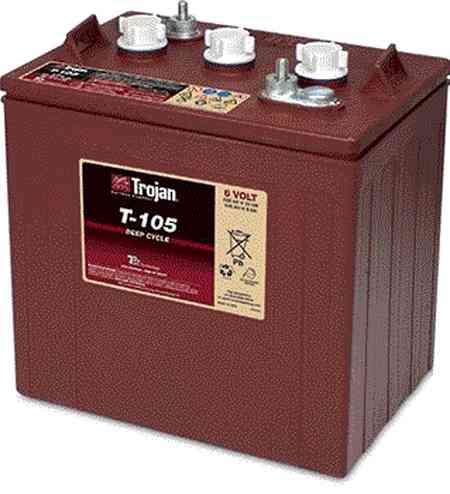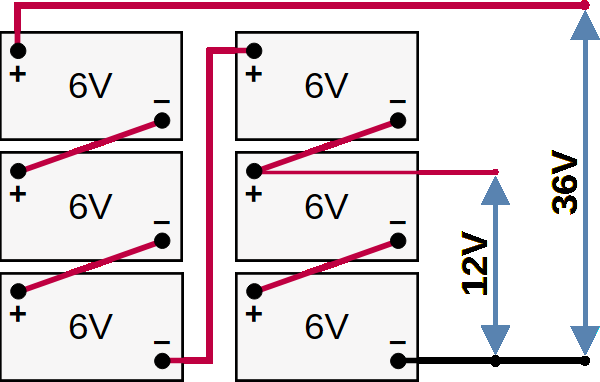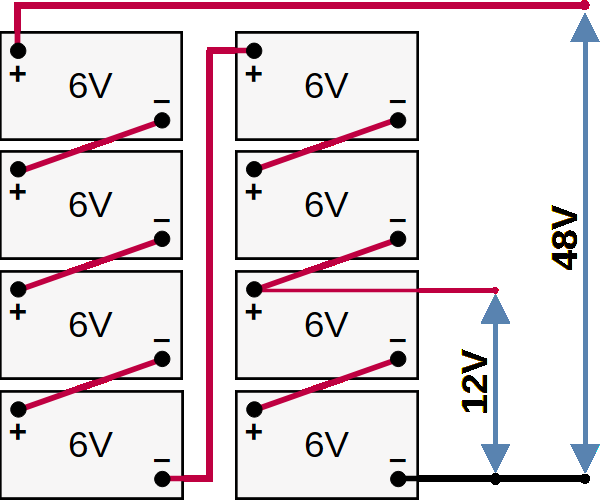Batteries & Related Systems
Batteries
Original Lead Acid Batteries
Type
The standard battery is the Trojan T-105 6 Volt deep cycle battery.
Trojan's web site
 provides a lot of helpful information, including proper maintenance. Most importantly,
these batteries require frequent water replenishment. There are battery watering
systems available that make the task easier by plumbing all batteries together to allow for
a single water feed.
provides a lot of helpful information, including proper maintenance. Most importantly,
these batteries require frequent water replenishment. There are battery watering
systems available that make the task easier by plumbing all batteries together to allow for
a single water feed.

Configurations
Duffy offered several battery configurations to provide different maximum voltages and power
levels for driving the propulsion system. There are 36V and 48V configurations which use
combinations of 6V batteries in series. Larger boats had a series-parallel battery option
with 16 batteries providing 48V.
12V is provided by tapping pairs of 6V batteries. This causes these battery pairs to
fail early, which is discussed
in the Issues section.


Other Battery Options
Lithium-Ion (Li-Ion)
Li-Ion batteries are a major upgrade from traditional flooded lead acid batteries, such as the Trojan T-105's that originally came with Duffy boats. The best type of Li-Ion batteries for boats is currently LiFePO4 due to the relative safety of this chemistry. Newer Duffy boats use Lithium Iron Phosphate (LiFePO4) batteries.
There are a lot of great web resources detailing the pros and cons of LiFePO4 vs flooded lead acid batteries. Here are the main benefits for a Duffy:
-
Longevity
Lead acid batteries are good for ~400 recharge cycles and degrade with each cycle. LiFePO4 batteries can handle 3,000+ recharge cycles with minimal degradation. -
Greater Useful Capacity
Lead acid batteries have a recommended maximum Depth of Discharge (DoD) of 50%. LiFePO4 battery recommended DoD is 80%. Lead Acid battery voltage rapidly drops while under heavy loads while LiFePO4 remains consistent.
Our Lead Acid batteries had a 225Ah capacity. Our Li-Ion batteries have a 200Ah capacity, but they provide far more power and range than the old batteries. -
No Maintenance
Lead acid batteries require water to be replenished and terminals often corrode due to the exposure to acid. LiFePO4 batteries are sealed and do not require maintenance. -
Accurate Battery Monitoring
LiFePO4 batteries include a battery management system that can provide an accurate reading of State of Charge (SoC). Most also have a Bluetooth app that will provide greater detail about SoC and charging. Duffy's standard indicator of battery life is a volt meter, which does a poor job of representing SoC. -
Light Weight
Six T-105's weigh 372 pounds vs 150 pounds for two equivalent LiFePO4 batteries. -
Fewer Batteries
You can get LiFePO4 batteries in a variety of voltages, including 36V and 48V, so you could power your boat with one or two batteries, reducing connections and complexity.
The down sides of LiFePO4 in a Duffy are:
- Higher initial cost, though the cost is rapidly dropping. The long-term cost is likely already at parity or better than lead acid before considering weight, maintenance, and monitoring benefits.
-
Some Rewiring will be necessary in order to provide the dual 36V/12V or 48V/12V
voltages required and to properly charge the LiFePO4 batteries.
The original 12V electrical system is powered by tapping two 6V batteries in the battery bank. This is a poor design as it causes unequal loading across the battery bank. An upgrade, which would likely be necessary with a LiFePO4 upgrade, is to use a DC/DC voltage converter. - Complexity. LiFePO4 batteries need a Battery Management System (BMS) to function. This is built-in to the battery housing. The quality of battery you choose may affect reliability.
AGM Batteries
Absorbent Glass Mat (AGM) batteries eliminate most of the maintenance issues of flooded lead acid batteries, but the cost/benefit is poor compared with an upgrade to LiFePO4.
Cheap 6V T-105 Replacements
Costco and others offer cheaper 6V flooded lead acid deep cycle batteries, but Trojan remains the standard. The cost and effort of replacing batteries is not worth the savings of buying cheaper batteries.
